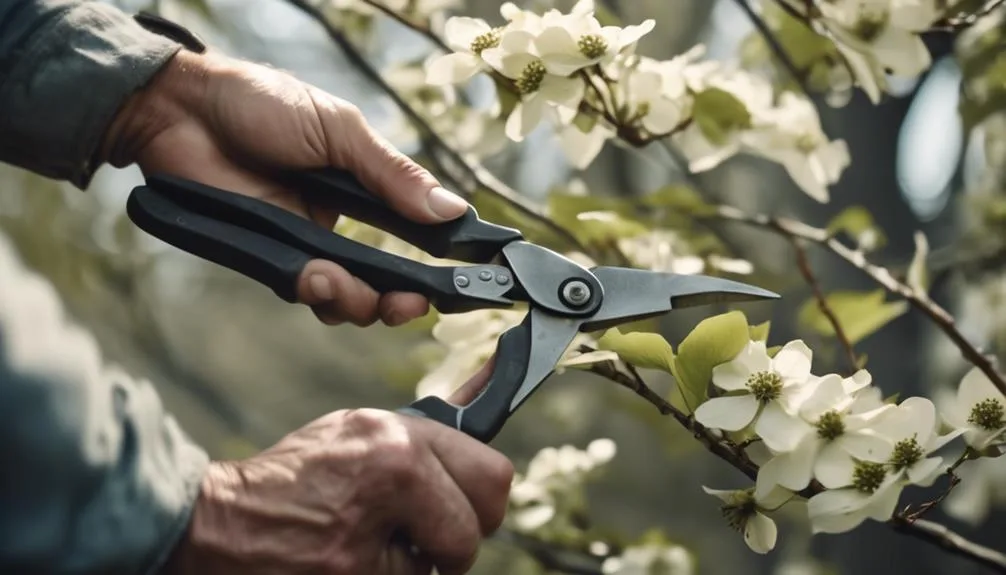Pruning your dogwood tree is essential for its health and appearance. Knowing the best methods for pruning is crucial.
When should you prune and how should you do it to benefit your tree? We'll explore the ideal timing and specific cuts that can help your dogwood tree thrive.
Think of it as a way to maintain your tree's natural beauty and ensure it continues to flourish.
Timing for Pruning Dogwood Trees
When pruning dogwood trees, it's crucial to consider the optimal timing to ensure the health and vibrancy of the tree. Seasonal pruning plays a significant role in maintaining the dogwood's growth patterns and overall well-being.
The best time to prune dogwood trees is during late winter or early spring while the tree is still dormant. This timing allows the tree to recover quickly and minimizes stress on the tree. Late winter pruning helps promote new growth and flowering in the spring.
Avoid pruning during the fall as this can make the tree more susceptible to diseases. By understanding the seasonal growth patterns of dogwood trees and timing your pruning accordingly, you can support the tree's health and ensure a beautiful display of blossoms in the following season.
Pruning Tools and Equipment
As you consider the optimal timing for pruning your dogwood trees during late winter or early spring, it's essential to have the right pruning tools and equipment to ensure the health and vibrancy of the tree. When it comes to pruning safety, always use sharp tools to make clean cuts. Dull blades can cause tearing and damage to the tree, leading to potential disease or pest infestation.
Keep your pruning tools sharp by regularly sharpening them with a file or sharpening stone. Invest in high-quality bypass pruners, loppers, and pruning saws to make precise cuts and avoid causing unnecessary stress to the tree. Additionally, using long-handled tools can help reach higher branches without the need for a ladder, ensuring your safety while pruning.
Understanding Pruning Cuts
To ensure the health and vitality of your dogwood trees, it's crucial to understand the proper techniques for making pruning cuts. When making pruning cuts on your dogwood trees, it's important to pay attention to the pruning angles and depth.
Pruning angles are essential to consider, as they can affect how the tree heals and grows after pruning. For dogwood trees, it's recommended to make pruning cuts at a 45-degree angle, sloping away from the bud or branch collar. This promotes quicker healing and prevents water from collecting on the cut surface.
Additionally, understanding the appropriate pruning depth is vital. When removing branches, make sure to cut just outside the branch collar, the swollen area where the branch meets the trunk. This helps the tree to compartmentalize the wound effectively, promoting healthy growth and reducing the risk of disease.
Techniques for Pruning Dogwood Trees
Prune your dogwood trees using proper techniques to ensure their health and vitality. When it comes to pruning techniques for dogwood trees, there are a few key methods to keep in mind:
- Timing is crucial: Prune your dogwood trees during late fall or winter to promote healing before the growing season begins.
- *Thinning cuts*: Remove select branches to allow more light and air to circulate within the tree, promoting overall health and vigor.
- *Heading cuts*: Trim the tips of branches to encourage new growth and maintain the tree's shape.
Using the right pruning techniques not only helps maintain the aesthetic appeal of your dogwood trees but also plays a crucial role in promoting their overall health and longevity.
Addressing Common Pruning Mistakes
Avoiding common pruning mistakes is essential for maintaining the health and beauty of your dogwood trees.
One of the most common mistakes is over-pruning, which can weaken the tree and make it more susceptible to diseases and pests. It's important to resist the urge to prune too much, especially in one pruning session.
Another mistake to avoid is improper timing. Pruning at the wrong time of year can stress the tree and interfere with its ability to heal properly.
Additionally, using dull or improper tools can lead to ragged cuts, bark damage, and an increased risk of disease.
To prevent these common pruning mistakes, adhere to proper pruning tips such as researching the best time to prune your specific type of dogwood, using sharp and clean tools, and avoiding excessive pruning.
Conclusion
Incorporating these best pruning methods for dogwood trees will help maintain their health and beauty over time. Timing, tools, and precision are key.
With careful pruning, your dogwood trees will thrive, enhancing the allure of your outdoor space.
Happy gardening!

My interest in trees started when I first saw the giant sequoias in Yosemite.
I was a teenager then, and I remember thinking, “I need to learn more about this.”
That moment stuck with me.
A few years later, I went on to study forestry at Michigan Tech.
Since graduating, I’ve worked in a mix of hands-on tree care and community education.
I’ve spent over ten years helping people understand how to plant, maintain, and protect the trees in their neighborhoods.
I don’t see trees as just part of the landscape.
They are living things that make a real difference in our daily lives.
